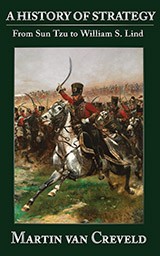REVIEW: A History of Strategy by Martin van Creveld
Saturday , 4, April 2015 Book Review Leave a comment I am unfamiliar with the subject of military strategy, other than what can be gleamed from a casual study of history and a healthy dose of military science-fiction. Nor am I a war-gamer, or even that good at laser tag. But like his other recent Castalia House release “Equality: The Impossible Quest”, Martin van Creveld delivers a commendable introduction for the interested amateur and (what I assume to be) an invaluable reference for the initiated.
I am unfamiliar with the subject of military strategy, other than what can be gleamed from a casual study of history and a healthy dose of military science-fiction. Nor am I a war-gamer, or even that good at laser tag. But like his other recent Castalia House release “Equality: The Impossible Quest”, Martin van Creveld delivers a commendable introduction for the interested amateur and (what I assume to be) an invaluable reference for the initiated.
The history van Creveld chronologically recounts is less about how particular campaigns were fought–you won’t find maps with arrows and formations–and more of a systematic survey of the world’s greatest military minds, both ancient and modern, in how they approached, conducted, and evaluated the art of war. Some of the writers–Sun Tzu, Machiavelli, and Clausewitz–you’ve probably heard of before. Others, like Jacques Francois de Chestnut, are less famous. What’s interesting is seeing the way they interact with each other’s work and how their ideas about warfare evolve. Sun Tzu regarded war as a necessary evil. Clausewitz as “politics by other means”. For us moderns, mutually assured destruction.
Van Creveld also tracks the development in philosophy and technology–from the ancient emphasis on the technical and tactical to the modern interest in the strategic and operational, from the phalanx to nuclear weapons. In each age, we see some attempt or another to compile a comprehensive theory of warfare. In that sense the book might have also been called “A Unified Theory of War: The Impossible Quest”.
I would have liked to seen a more in-depth discussion on the difference between grand strategy, operational strategy and tactics, but the delineations are more or less assumed.
If your curiosity has been piqued, as mine was, the “Further Reading” list at the end of the book will occupy enough of your time for the rest of the year. Put this one on the digital shelf if you want a handy reference guide.
Please give us your valuable comment